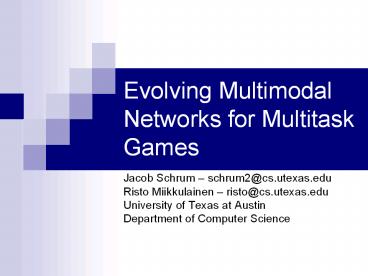Evolving Multimodal Networks for Multitask Games PowerPoint PPT Presentation
Title: Evolving Multimodal Networks for Multitask Games
1
Evolving Multimodal Networks for Multitask Games
- Jacob Schrum schrum2_at_cs.utexas.edu
- Risto Miikkulainen risto_at_cs.utexas.edu
- University of Texas at Austin
- Department of Computer Science
2
- Evolution in videogames
- Automatically learn interesting behavior
- Complex but controlled environments
- Stepping stone to real world
- Robots
- Training simulators
- Complexity issues
- Multiple contradictory objectives
- Multiple challenging tasks
3
Multitask Games
- NPCs perform two or more separate tasks
- Each task has own performance measures
- Task linkage
- Independent
- Dependent
- Not blended
- Inherently multiobjective
4
Test Domains
- Designed to study multimodal behavior
- Two tasks in similar environments
- Different behavior needed to succeed
- Main challenge perform well in both
5
Front/Back Ramming
- Same goal, opposite embodiments
- Front Ramming
- Attack w/front ram
- Avoid counterattacks
- Back Ramming
- Attack w/back ram
- Avoid counterattacks
6
Predator/Prey
- Same embodiment, opposite goals
- Predator
- Attack prey
- Prevent escape
- Prey
- Avoid attack
- Stay alive
7
Multiobjective Optimization
High health but did not deal much damage
- Game with two objectives
- Damage Dealt
- Remaining Health
- A dominates B iff A is
strictly better in
one
objective and at least
as good in others - Population of points
not dominated are best
Pareto Front - Weighted-sum provably
incapable of capturing
non-convex front
Tradeoff between objectives
Dealt lot of damage, but lost lots of health
8
NSGA-II
- Evolution natural approach for finding optimal
population - Non-Dominated Sorting Genetic Algorithm II
- Population P with size N Evaluate P
- Use mutation to get P size N Evaluate P
- Calculate non-dominated fronts of P È P size
2N - New population size N from highest fronts of P È
P
K. Deb et al. A Fast and Elitist Multiobjective
Genetic Algorithm NSGA-II. Evol. Comp. 2002
9
Constructive Neuroevolution
- Genetic Algorithms Neural Networks
- Build structure incrementally (complexification)
- Good at generating control policies
- Three basic mutations (no crossover used)
Perturb Weight
Add Connection
Add Node
10
Multimodal Networks (1)
- Multitask Learning
- One mode per task
- Shared hidden layer
- Knows current task
- Previous work
- Supervised learning context
- Multiple tasks learned quicker than individual
- Not tried with evolution yet
R. A. Caruana, "Multitask learning A
knowledge-based source of inductive bias" ICML
1993
11
Multimodal Networks (2)
Starting network with one mode
- Mode Mutation
- Extra modes evolved
- Networks choose mode
- Chosen via preference neurons
- MM Previous
- Links from previous mode
- Weights 1.0
- MM Random
- Links from random sources
- Random weights
- Supports mode deletion
MM(R)
MM(P)
12
Experiment
- Compare 4 conditions
- Control Unimodal networks
- Multitask One mode per task
- MM(P) Mode Mutation Previous
- MM(R) Mode Mutation Random Delete Mutation
- 500 generations
- Population size 52
- Player behavior scripted
- Network controls homogeneous team of 4
13
MO Performance Assessment
- Reduce Pareto front to single number
- Hypervolume of
dominated region - Pareto compliant
- Front A dominates
front B implies
HV(A) gt HV(B) - Standard statistical
comparisons of
average HV
14
(No Transcript)
15
Front/Back Ramming Behaviors
Multitask
MM(R)
16
(No Transcript)
17
Predator/Prey Behaviors
Multitask
MM(R)
18
Discussion (1)
- Front/Back Ramming
- Control lt MM(P), MM(R) lt Multitask
- Multiple modes help
- Explicit knowledge of task helps
19
Discussion (2)
- Predator/Prey
- MM(P), Control, Multitask lt MM(R)
- Multiple modes not necessarily helpful
- Disparity in relative difficulty of tasks
- Multitask ends up wasting effort
- Mode deletion aids search for one good mode
20
How To Apply
- Multitask good if
- Task division known, and
- Tasks are comparably difficult
- Mode mutation good if
- Task division is unknown, or
- Obvious task division is misleading
21
Future Work
- Games with more tasks
- Does method scale?
- Control mode bloat
- Games with independent tasks
- Ms. Pac-Man
- Collect pills while avoiding ghosts
- Eat ghosts after eating power pill
- Games with blended tasks
- Unreal Tournament 2004
- Fight while avoiding damage
- Fight or run away?
- Collect items or seek opponents?
22
Conclusion
- Domains with multiple tasks are common
- Both in real world and games
- Multimodal networks improve learning in multitask
games - Will allow interesting/complex behavior to be
developed in future
23
Questions?
Jacob Schrum schrum2_at_cs.utexas.edu Risto
Miikkulainen risto_at_cs.utexas.edu University of
Texas at Austin Department of Computer Science

